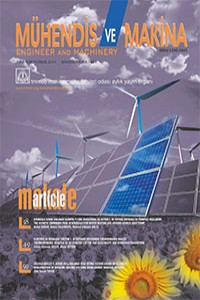Öz
In this study, low exergy systems are explained regarding the exergy term. In heating systems energy
and exergy flows pass through from the generation stage to the building envelope. To evaluate the
system, every stage should be investigated according to energy and exergy flows. In this context an
example building heating system is studied. By using the exergy analysis, it is possible to determine
the efficient and inefficient stages in the system. Total exergy input rate to the system is calculated as
107 kW. The maximum exergy loss rate is found to be 65.23 kW which took place in the generation
stage. The energy and exergy efficiencies of the heating system are calculated as 45.7% and 3.5%,
respectively.
Anahtar Kelimeler
Kaynakça
- 1. International Energy Agency. 2015. "Key World Energy Statistics," https://www.iea.org/publications/freepublications/publication/KeyWorld2015.pdf , son erişim tarihi: 07.03.2016.
- 2. Schmidt, D. 2004. “Design of Low Exergy Buildings-Method and a Predesign Tool,” International Journal of Low Exergy and Sustainable Buildings, vol. 3, p.1-47.
- 3. Balta, M. T., Kalinci, Y., Hepbasli, A. 2008. “Evaluating a Low Exergy Heating System from the Power Plant through the Heat Pump to the Building Envelope,” Energy and Buildings, vol. 40, p. 1799-1804.
- 4. Shukuya, M. 2009. “Exergy Concept and its Application to the Built Environment,” Building and Environment, vol. 44, p. 1545-1550.
- 5. Yıldız, A., Gungor, A. 2009. “Energy and Exergy Analyses of Space Heating in Buildings,” Applied Energy, vol. 86, p. 1939-1948.
- 6. Hasan, A., Kurnitski, J., Jokiranta, K. 2009. “A Combined Low Temperature Water Heating System Consisting of Radiators and Floor Heating,” Energy and Buildings vol. 41, p. 470-479.
- 7. Balta, M. T. 2012. “Exergetic Cost Analysis and Sustainability Assessment of Various Low Exergy Heating Systems,” Energy and Buildings, vol. 55, p. 721-727.
- 8. Han, T., Zheng, Y., Gong, G. 2015. “Exergy Analysis of Building Thermal Load and Related Energy Flows in Buildings,” Indoor and Built Environment, November 3, doi:10.1177/1420326X15612881.
- 9. International Energy Agency (IEA). 2011. “Low Exergy Systems for High Performance Buildings and Communities,” Annex 49, http://www.annex49.com/materials.html, son erişim tarihi: 20.03.2013.
- 10. Türk Standartları Enstitüsü. 1998. TS 825, Binalarda Isı Yalıtım Kuralları.
Öz
Bu çalışmada, ekserji kavramı anlatılarak düşük ekserjili sistemler hakkında bilgi verilmiştir. Isıtma
sistemlerinde enerji ve ekserji akımları ısı üretim basamağından bina kabuğuna kadar geçmektedir.
Sistemin değerlendirilebilmesi için her basamaktaki enerji ve ekserji akımlarının incelenmesi gerekmektedir. Bu kapsamda örnek bir ısıtma sistemi incelenmiştir. Ekserji analizi yöntemiyle, sistemde
yer alan verimli ve verimsiz basamakların tespit edilmesi mümkün olmaktadır. Sisteme giren toplam
ekserji akısı 107 kW olarak bulunmuştur. En büyük ekserji kaybı akısı 65,23 kW olarak ısı üretim
basamağı için hesaplanmıştır. Isıtma sisteminin enerji ve ekserji verimleri sırasıyla, %45,7 ve %3,5
olarak bulunmuştur.
Anahtar Kelimeler
Kaynakça
- 1. International Energy Agency. 2015. "Key World Energy Statistics," https://www.iea.org/publications/freepublications/publication/KeyWorld2015.pdf , son erişim tarihi: 07.03.2016.
- 2. Schmidt, D. 2004. “Design of Low Exergy Buildings-Method and a Predesign Tool,” International Journal of Low Exergy and Sustainable Buildings, vol. 3, p.1-47.
- 3. Balta, M. T., Kalinci, Y., Hepbasli, A. 2008. “Evaluating a Low Exergy Heating System from the Power Plant through the Heat Pump to the Building Envelope,” Energy and Buildings, vol. 40, p. 1799-1804.
- 4. Shukuya, M. 2009. “Exergy Concept and its Application to the Built Environment,” Building and Environment, vol. 44, p. 1545-1550.
- 5. Yıldız, A., Gungor, A. 2009. “Energy and Exergy Analyses of Space Heating in Buildings,” Applied Energy, vol. 86, p. 1939-1948.
- 6. Hasan, A., Kurnitski, J., Jokiranta, K. 2009. “A Combined Low Temperature Water Heating System Consisting of Radiators and Floor Heating,” Energy and Buildings vol. 41, p. 470-479.
- 7. Balta, M. T. 2012. “Exergetic Cost Analysis and Sustainability Assessment of Various Low Exergy Heating Systems,” Energy and Buildings, vol. 55, p. 721-727.
- 8. Han, T., Zheng, Y., Gong, G. 2015. “Exergy Analysis of Building Thermal Load and Related Energy Flows in Buildings,” Indoor and Built Environment, November 3, doi:10.1177/1420326X15612881.
- 9. International Energy Agency (IEA). 2011. “Low Exergy Systems for High Performance Buildings and Communities,” Annex 49, http://www.annex49.com/materials.html, son erişim tarihi: 20.03.2013.
- 10. Türk Standartları Enstitüsü. 1998. TS 825, Binalarda Isı Yalıtım Kuralları.
Ayrıntılar
| Birincil Dil | Türkçe |
|---|---|
| Bölüm | icindekiler-sunuş |
| Yazarlar | |
| Yayımlanma Tarihi | 17 Kasım 2016 |
| Gönderilme Tarihi | 20 Mart 2016 |
| Kabul Tarihi | 31 Ekim 2016 |
| Yayımlandığı Sayı | Yıl 2016 Cilt: 57 Sayı: 681 |
Derginin DergiPark'a aktarımı devam ettiğinden arşiv sayılarına https://www.mmo.org.tr/muhendismakina adresinden erişebilirsiniz.
ISSN : 1300-3402
E-ISSN : 2667-7520


